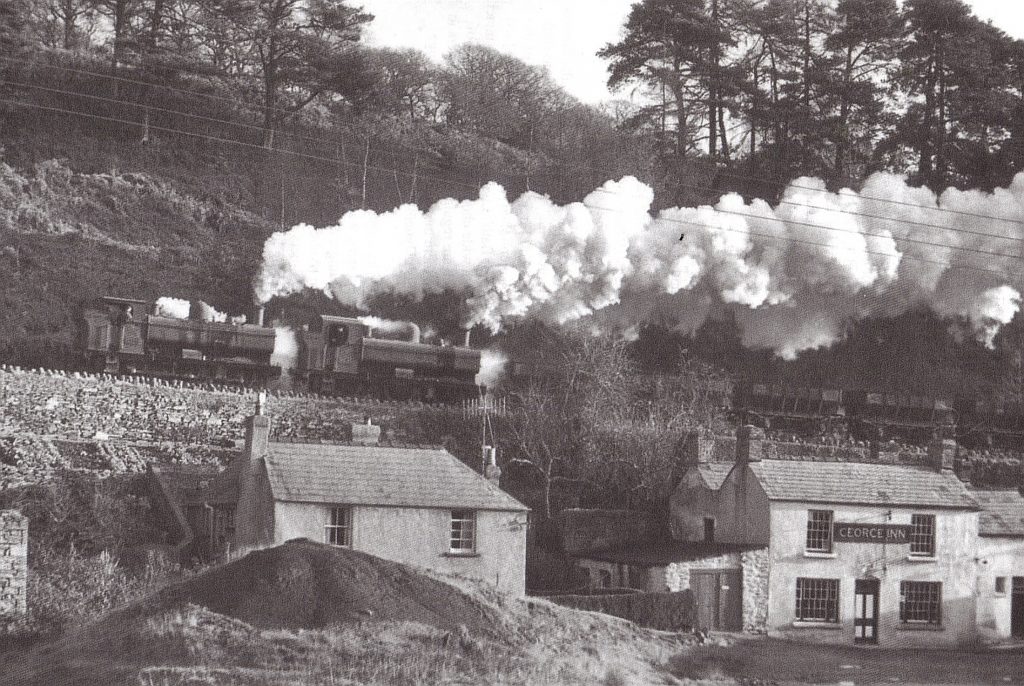Fetter Hill is a hamlet about a mile and a half to the south east of Coleford on the road from Parkend to Coalway. The area was once heavily mined for both coal and iron. Quarrying, stone works and brick making also took place near Fetter Hill. It is difficult to image a scene of industrial activity in the present-day rural landscape where mature trees now proliferate.
There were once two pubs in Fetter Hill to cater for the needs of the local workforce – the Royal Oak and the George Inn.
Elizabeth Blanch owned the George Inn in 1891 and 1903. Classified as an alehouse it had an annual rateable value of £14.0s.0d. and ‘last orders’ were called each night for the 10 pm closure. Although free of brewery tie in 1891 the lease had been taken by the Cambrian Brewery in Newport (Lloyd & Yorath & Co.) twelve years later in 1903.

Gloucester Citizen, Wednesday 14th February 1951 – Magistrates warn licensees, Premises must be improved: A threat that the licences of 11 public houses in the Coleford division would not be renewed unless plans for improving their cleanliness and general sanitary conditions were put forward, was made by the Chairman (Mr D.J. Percival) at the Coleford Petty Sessional annual licensing meeting yesterday. The chairman said: “There is one case in particular at the George, Fetter Hill, where a scheme has been prepared but nothing has been done. It has been put off and put off and we are seriously considering whether it is a genuine application, for we are informed that there would be no difficulty in the way of labour or materials.”
The George Inn was immediately in front of the railway embankment carrying the Coleford branch line. At this point the railway was on a very steep gradient leading towards Coleford. The gradient was 1 in 30, which was extremely demanding for steam engines. The photograph above, courtesy of Ben Ashworth, shows two Great Western Railway pannier tank locomotives taking a coal train bunker first up the gradient towards Coleford. They are working to their limit as clouds of white exhaust are seen billowing from their chimneys. You can almost hear the cacophonic roar as the two ex GWR steam engines struggle up the hill with their heavy load of coal. The branch line survived until 1967 and was mainly used to take ballast extracted from Whitcliff Quarry to the east of Coleford down the gradient to Parkend and on towards Lydney Junction to the main South Wales railway line. The route of the old railway is now a cycle path / footpath and the severe gradient is very noticeable cycling uphill towards Coleford.

Nestling in the shadow of the railway embankment undisturbed by the commotion is the humble George Inn; a typical forest pub with whitewashed exterior and slate roof. I must confess that as a train spotter and beer lover this isolated spot in the Forest of Dean must have been the nearest thing to heaven. Imagine supping rare pints of Lloyd & Yorath’s Cambrian Ales from Newport in Edwardian times in the backyard of the George Inn and watching and listening to the heroic exploits of the whining, hissing leviathans of the Great Western Railway heading up the gradient in a mild inebriated bliss. Or the squealing of the wheels and clattering of trucks on the downward descent.
Fred Cook from Nottingham contacted me in 2006 with his memories of the George Inn at Fetter Hill. He wrote:
I can remember the George Inn from my childhood. I am now 60. In those days I used to go on holiday from London to the Forest of Dean with my parents and they took me into the George when they went for a lunchtime or evening drink. The elderly landlords of the George Inn were Mr and Mrs Barnard. Their daughter used to help out in the bar from time to time. The pub was simple and basic. There was a passage running through the middle of the building back from the front door to the back. There was no bar as such. Instead there was a beer-servery half-way along the passage to the right behind a wooden and glass partition. The main drinking room ran from the front of the building to the back on the left-hand side of the passage with doors in and out at the very front and back of the room. The furnishings were plain wooden benches and seats with old tables. There was a small room to the front of the pub on the right-hand side of the passage where a few ancient pub games could be found. I think there was an indoor quoits game. There was some singing on Saturday nights but I do not recall whether there was a piano of any sort. The beer was Ansells from Birmingham and there was traditional cider. I can remember being taken around the cellar which was situated at the back of the pub. There was a railway line immediately behind the George but I cannot recall seeing any trains during my visits with my parents. I think the pub closed down in the early to mid-sixties. It is sad that such traditional pubs have faded away.
The George was converted to a private house in 1973 but may have been closed as a pub for some time even then.
Landlords at the George Inn include:
1876 John Carter (George Inn, Futterill)
1885,1891 Richard Nelmes
1902 George Porter
1903 John W. Porter
1906 George Porter
1919 Edward Hale
1927,1939 James Barnard

